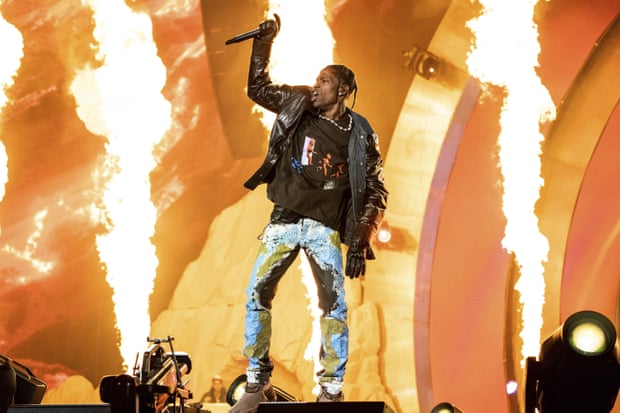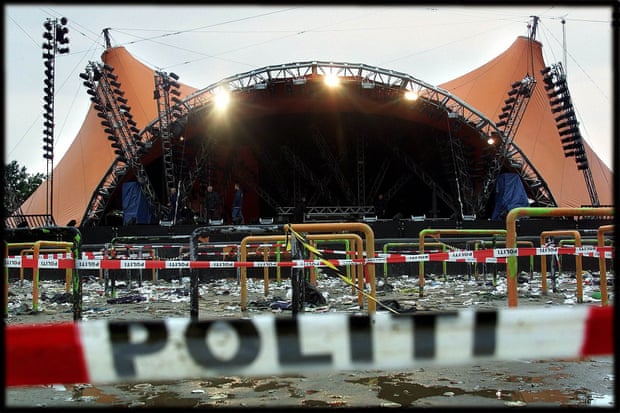The show must go on – except when it shouldn’t. In 2022, scarcely a week goes by without a major artist stopping a gig for safety reasons such as preventing crowd surges or alerting the medical team.
In July, Adele stopped her Hyde Park show four times to help overheating fans. Harry Styles repeatedly pressed pause during his latest tour earlier this year; Doja Cat waited five minutes for security to sort out an issue at Lollapalooza Argentina, and Sam Fender warned fans to stop fighting at his Glasgow gig. Pharrell Williams, Slipknot, Ed Sheeran, John Mayer, Lady Gaga, Billie Eilish and the Killers have also had to act as crowd control.
This cautiousness is evidently the product of the Astroworld festival disaster last November. Run by the rapper Travis Scott, the event saw a fatal crowd crush cause the deaths of 10 fans and injure more than 300.
Scott was criticized for allegedly disregarding fans’ pleas to stop the show, although he described how he had paused it several times, including when an ambulance arrived, “to just make sure everyone was OK”. He has denied responsibility, saying he was unaware that anything was amiss until after his set of him.
“I would guarantee that since Astroworld, management companies are saying to their artists: if you see this happening, do not in any circumstances incite the crowd,” says Steve Allen. A tour manager for Led Zeppelin, Blur, Pulp and Red Hot Chili Peppers, he is now head of the consultancy organization Crowd Safety and was an expert witness in the Astroworld civil lawsuits. “If someone is saying stop the show, then stop the show. If not, it’ll be the end of your career.”

In September 1997, Allen coined the term “showstop procedure” while working with Oasis. At a gig in Aberdeen, the energy of the crowd was so “off the Richter scale” that it necessitated establishing a formal plan of action in the event of future mishap. “I explained to Noel that if we didn’t have this system in place, there’s a strong possibility that someone’s going to get seriously hurt.”
The system he set up saw him stand on the stage barrier ready to signal to the Gallaghers if the crowd’s safety was compromised. It was an overwhelming success, he says. “We had it down to a tee. We must have stopped 17 to 25 different shows around the world; the band were 100% compliant. They didn’t want a death or a major incident at their concerts, simple as that.”
The founder of Mind Over Matter Consultancy, Prof Chris Kemp, who started the world’s first crowd management degree, says that the procedure worked because it came from the band themselves. “Anyone else who tried to get on stage and do that [wouldn’t have worked]. The Gallagher brothers actually cared about what happened.”
So did Allen’s team, who he says accepted ridicule for wearing noise-cancelling headphones to communicate with one another – as opposed to clip-on mic headsets – before they went mainstream. Given that people die within three minutes of not having oxygen, he says, you “need to hear.”
While shows had been stopped before – Nirvana stopped a show in Oakland in 1993 to challenge a sexual assault in the crowd – it was Allen’s codification of the procedure in 1997 that made it a serious tool in the crowd manager’s arsenal, and one now widely used by security staff worldwide.
The vast majority of crowd management today is still preventive rather than – as with the showstop procedure – reactive. “There needs to be a clear understanding of roles and responsibilities,” Allen explains, referring to the extensive planning he undertook for Eminem’s Anger Management tour, in which they invited the police force from the city of the subsequent gig to prepare by attending the one before .

In 2016, Kemp worked with the Roskilde festival in Denmark – the scene of a 2000 tragedy where nine people were crushed to death during Pearl Jam’s performance – to establish a meticulous protocol including a system of staggered entry to reduce crushes. “The more you plan, the more you can mitigate the chances,” says Kemp.
“Shit,” though, as Allen says, “can happen.” It’s why the showstop procedure is still a key part of reactive management, the final emergency mechanism at the end of a daisy chain of safe practices.
Astroworld has made touring teams aware of the risks of not having such a procedure in place: as well as the potential injury to life, musicians may face legal, reputational and financial repercussions. The world’s richest artists make more than 75% of their income from touring. A gig in which a crowd feels unsafe or prompts backlash online could mean ticket sales plunging or heightened infrastructure fees. “The promoter will turn around and say: ‘For you to play here the local authority have insisted I have to double my security, so my profit is now cut,’” says Allen.
Increasingly, it’s the artist who triggers it. Fans have quickly come to understand these gig pauses as reflecting genuine concern on the part of the artist. Post-Astroworld, Billie Eilish was widely praised as one of the first musicians to pause proceedings in order to get a fan an inhaler. In turn, this reactivity from artists has created an expectation of safety among fans – particularly as they and their favorite artists return to a changed industry.
After nearly 18 months of being deprived of live music, crowds are generally more excited across the board. “You might think Rod Stewart: no problem at all. Wrong!” Allen says. “I see the genuine excitement among [all people at gigs] as if they have a Willy Wonka ticket.”
In these particularly frenzied moments, performers will chat to their teams between songs and perhaps opt for a slower number to simmer down the energy in a room. “That decision is about safety,” says Kemp. “It’s not difficult to make things work. It’s not just about money.”
Another side-effect of the pandemic is that many highly trained security staff were forced to retrain in other fields owing to the absence of work, which has led to venues working with less-qualified operatives. “The pedigree that was there has been significantly diluted,” says Allen.
Allen and Kemp are divided on whether the performer should hold the ultimate responsibility for crowd safety. “Everyone has a duty of care, but the artists are up on that stage to perform for a crowd,” says Allen. “They should have people in place via the promoter.”
Kemp disagrees. “If [they] believe the whole show is about them, that’s when you’ve got to challenge it. The artists have to accept the show is for the audience and deliver the safest [performance].” And while AI technology, such as dynamic crowd measurement, can record crowd mood and compliance, it’s the artist who has the best view, he says. “And that links the artists and the teams in the venue.”
Regardless, seeing artists getting involved in crowd safety is undoubtedly a positive trend, says Kemp. “If you haven’t actually got an audience, what use is that?”